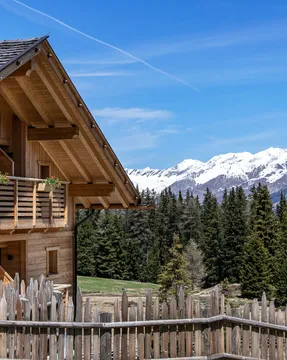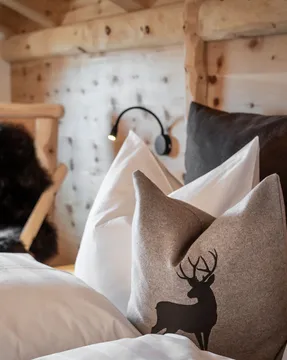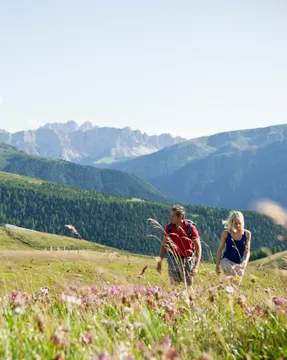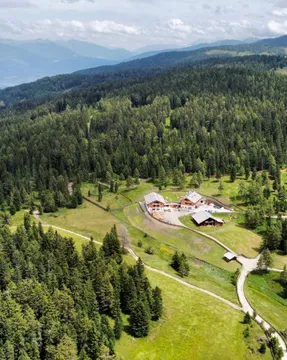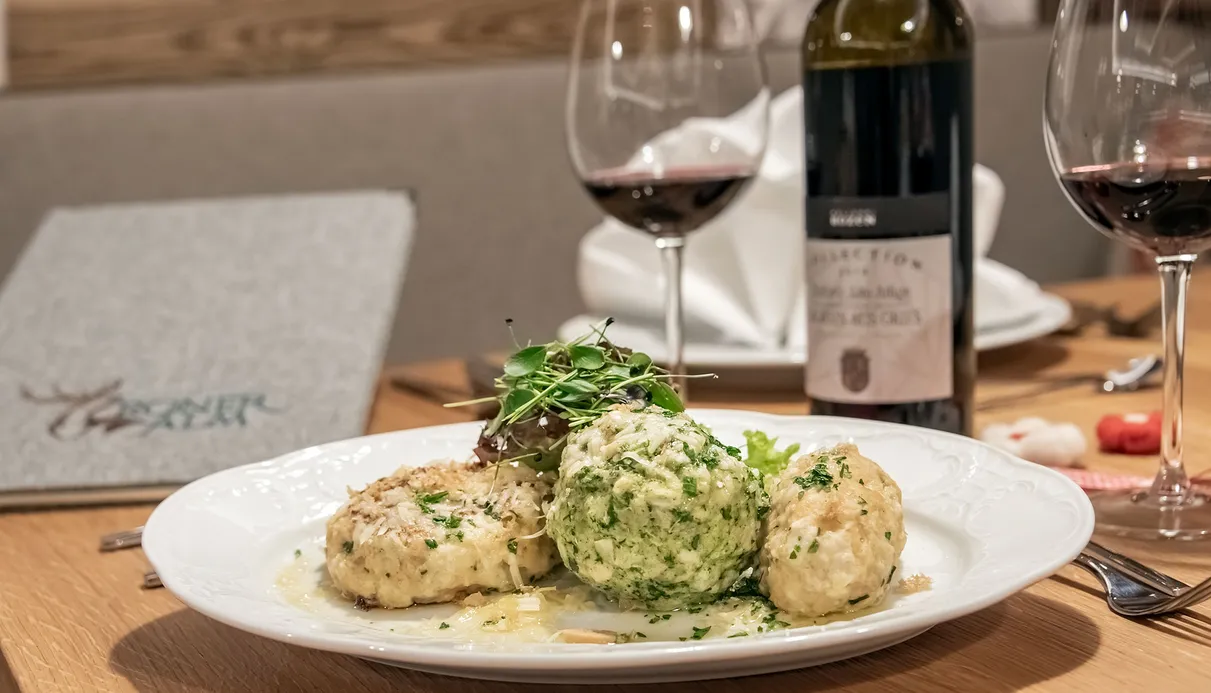Stale bread. Milk. Eggs. There's not much more to this delicious South Tyrolean cultural speciality. Purists will be delighted by the bread dumpling, while those with a heart for savoury dishes will be happy with a bacon dumpling. Plant eaters will go for dumplings with spinach, beetroot or wild herbs and sweet-toothed people will savour a poem of curd cheese and fruit.
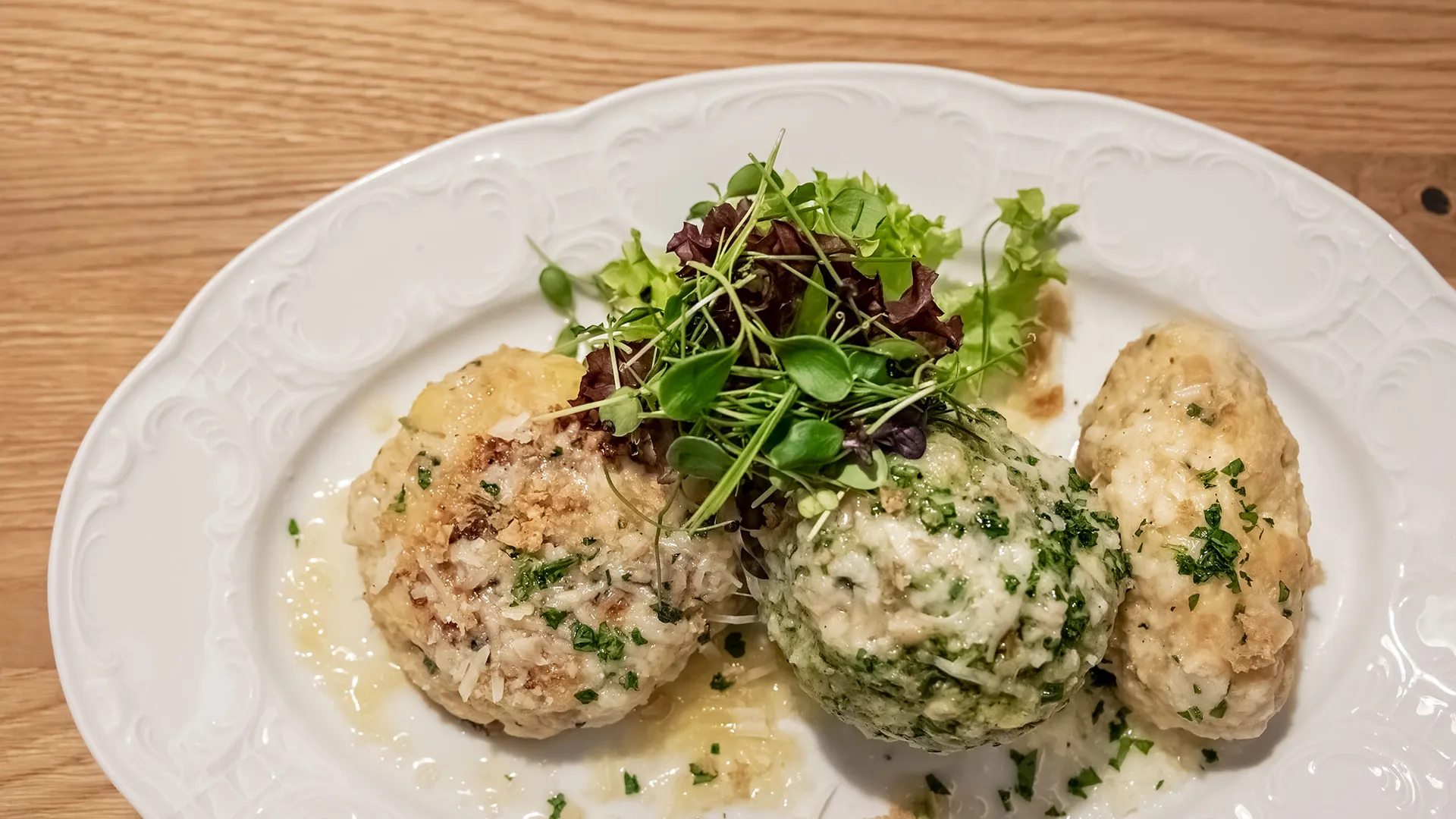
South Tyrolean dumplings:
round balls of happiness
“Knedl” are South Tyrol's signature dish and the object of desire for hungry mountain sports enthusiasts. At the Naturhotel Runa, we delight guests with our creations during the summer months – chef Alex serves his classics and new interpretations daily from 11 a.m. to 5 p.m. If you would like to learn more about South Tyrol's national dish, read on. We have compiled some bizarre, funny and informative facts about dumplings for you. At the bottom of the page, you will find our favourite recipe for nettle dumplings.
Beating the pyramids: dumplings are ancient
Archaeologists in Switzerland have unearthed dumpling remains that were cooked over 5,600 years ago. This proves that dumplings are older than Stonehenge and the Egyptian pyramids.
Like a painting: the dumpling eater
About an hour's drive from Runa, at Hocheppan Castle, a mysterious mural awaits you. The 13th-century fresco depicts a ‘dumpling eater’. Some speculate: is this the Mother of God enjoying a South Tyrolean dumpling?
Legendary: South Tyrol's dumplings
A heart-warming peasant legend tells of a desperate maid who was able to appease marauding mercenaries with an improvised meal of bacon, sausage and old bread. The soldiers were so delighted with the first bacon dumplings that they left gold coins as a token of their gratitude. Perhaps the first documented review of dumplings in history!
Almost sacred: the dumpling trinity
Any self-respecting restaurateur in South Tyrol serves the trinity: bacon dumplings, spinach dumplings and cheese dumplings. Not entirely correct, but delicious: a Schlutzer instead of a cheese dumpling.
Elemental: Alpine cuisine
A centuries-old saying sums up the essence of Tyrolean cuisine: ‘Dumplings, noodles, gnocchi and flatbread are the four elements of Tyrol.’ In other words, dumplings are an integral part of Alpine cooking culture.
Zero waste: sustainable since the beginning
Dumplings are a prime example of sustainable cuisine, as they offer a creative way to use up leftovers. What is celebrated today as ‘zero waste’ has been practised by South Tyroleans for centuries. Anything that tastes good can go into dumplings.
Taboo: dumplings and knives
It's even in the etiquette guide: dumplings should never be cut with a knife, but only with a spoon or fork!
Topless: cooking dumplings
Dumplings feel most comfortable in a pot without a lid. And you can always keep an eye on your delicacies. You don't want them to fall apart.
Dumplings are “social animals”
It gives them stability and helps them cook evenly: dumplings like to ‘cuddle’ in the pot. This means that you should place the dumplings close together in the pot so that they retain their shape during cooking and do not fall apart.
The dumpling festival in Sterzing
Every year on the second Sunday in September, the small town of Sterzing (about 40 km from Runa) is transformed into a veritable dumpling metropolis. On a 400-metre-long table (!) through the old town, farmers' wives and restaurateurs serve 70 different types of dumplings.
Wild and wonderful: Runa's nettle dumplings (approx. 8 dumplings):
- First peel 60 g of onion and 1 clove of garlic, chop both finely and sauté in 2 tablespoons of butter until translucent.
- Then finely chop 100 g of cooked spinach leaves and 100 g of cooked nettles, add them to the onion mixture and season with salt, freshly ground pepper and a pinch of grated nutmeg. Purée the mixture together with 2 eggs in a blender until smooth.
- Place the puréed mixture in a large bowl, add 50 ml milk, 30 g diced cheese, 1 tablespoon flour, salt and pepper. Mix everything thoroughly with 150 g diced white bread or breadcrumbs. Cover and leave the mixture to rest for about 15 minutes. In the meantime, bring a large pot of water to the boil.
- With moistened hands, shape about 8 dumplings and carefully place them in the boiling water. Leave them to simmer for 15 to 20 minutes – they should not boil, but simmer gently.
- Serve the finished dumplings with 30 g freshly grated Parmesan and 70 g golden brown butter
